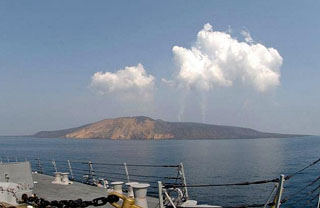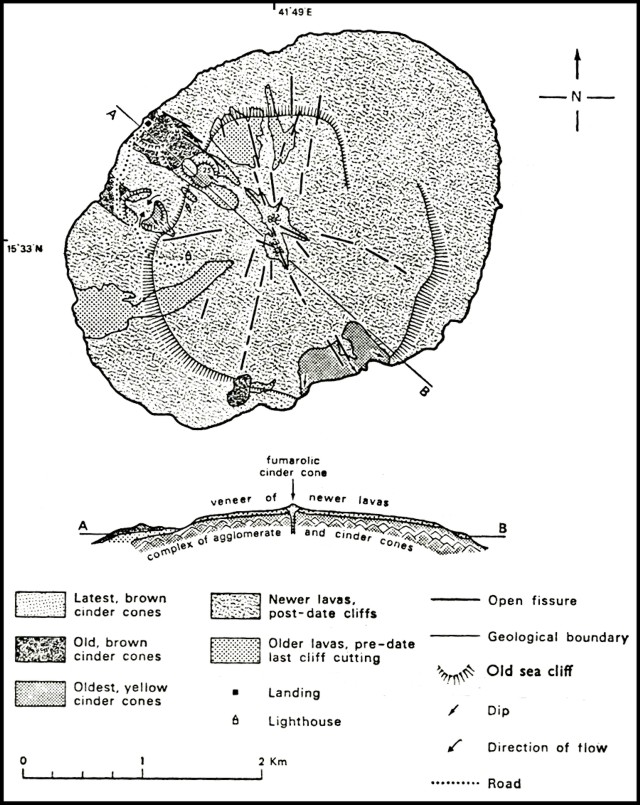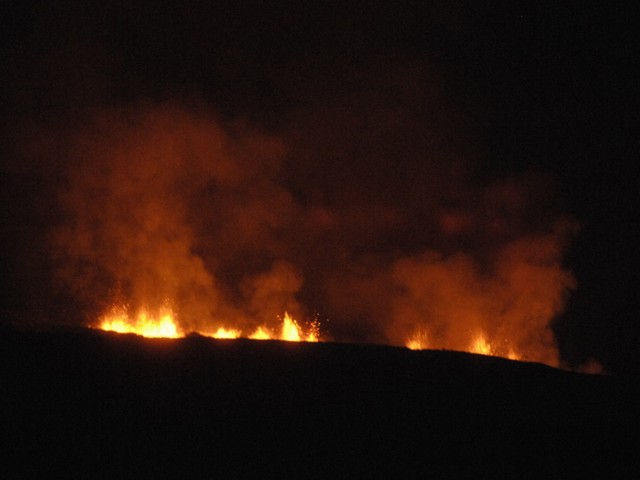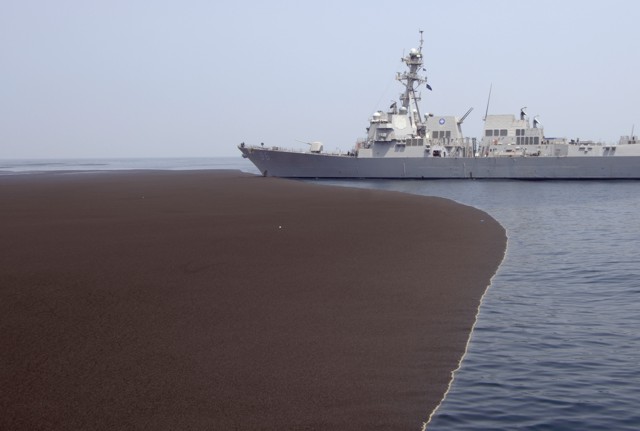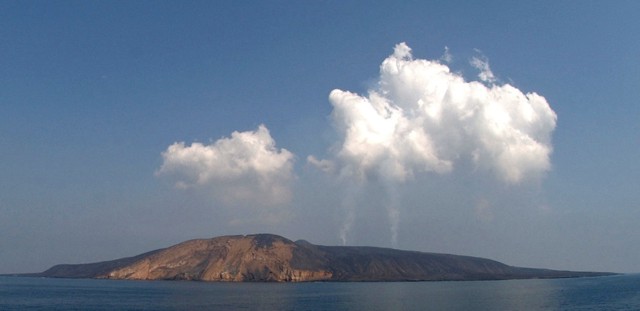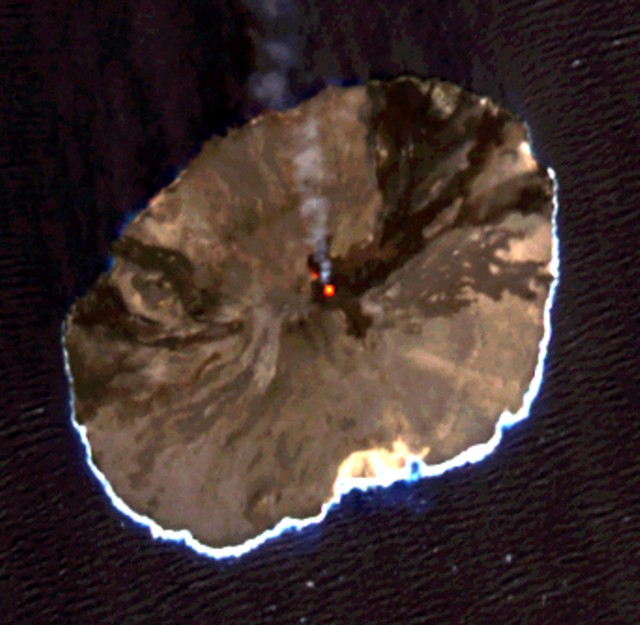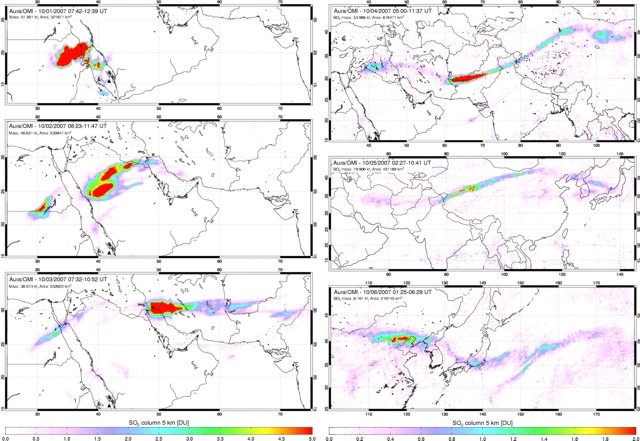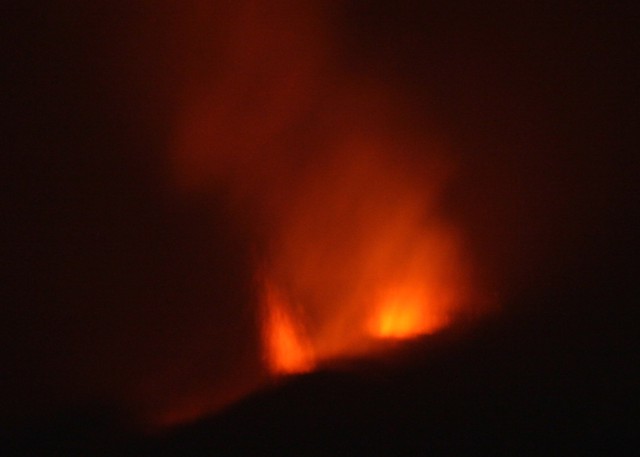Report on Jebel at Tair (Yemen) — October 2007
Bulletin of the Global Volcanism Network, vol. 32, no. 10 (October 2007)
Managing Editor: Richard Wunderman.
Jebel at Tair (Yemen) Eruption on 30 September sends lava flows to the ocean; fatalities among soldiers
Please cite this report as:
Global Volcanism Program, 2007. Report on Jebel at Tair (Yemen) (Wunderman, R., ed.). Bulletin of the Global Volcanism Network, 32:10. Smithsonian Institution. https://doi.org/10.5479/si.GVP.BGVN200710-221010
Jebel at Tair
Yemen
15.55°N, 41.83°E; summit elev. 244 m
All times are local (unless otherwise noted)
An eruption that began on the afternoon of 30 September 2007 from Jebel at Tair (figure 1) sent lava flows across the NE part of the 2 x 3 km island to the sea, and resulted in fatalities among Yemen military personnel. The eruption continued through at least the end of November. A wide variety of spelling variations have been used to identify this island volcano, which is generally translated as meaning "Bird Island" in English; the name used in this report is based on Gass and others (1973). The following information is based on a compilation of news media reports, observations and reports from NATO (North Atlantic Treaty Organization) ship crews that assisted with search and rescue operations, and satellite data.
A survivor rescued by the HMCS Toronto, Ahmad Abdullah al-Jalal, stated that the eruption "started with shocks like quakes, and then we heard huge blasts with lava and rocks spewing out and dropping on us." Al-Jalal also said that he and six fellow soldiers decided to flee the island by trying to swim through "boiling water" surrounding the island. He claimed to have entered the water at 1530 local time, shortly after the eruption began.
Before the island was visible on the horizon from the NATO ships, the glow of molten rock could be seen lighting up the night sky and a spout of lava was clearly visible. As the ships arrived just after dusk, the crews saw multiple lava flows moving down the slopes. Lava flows and fire fountains were visible on the infrared camera of the Shipboard Electro-Optical Sensor System (SEOSS), though with the naked eye sailors could make out a faint red glow in the cloud of steam and smoke. The infrared camera allowed sailors to watch the lava flow down the slopes into the water, and the enormous pillar of steam rising above it. Photographs and video clearly showed that the source of the lava flows was not confined to a vent near the summit, but was also originating from NE flank fissures that were producing multiple fire fountains (figure 2). Small boats approached within 15 m of the lava-flow ocean entries, where sailors could feel the heat from the lava, steam plumes, and heated seawater.
Ash plumes were also observed by shipboard observers rising 300 m. Tephra from the activity fell into the water and created floating rafts of ash and pumice that were described in some news reports as extending almost 10 km from the island. NATO ships later encountered the volcanic material 20 km away (figure 3). Lava flows at the shoreline on 2 October remained fluid in some areas (figure 4), while others were steaming (figure 5). Enough steam was rising from the lava flows on the NE side of the island to form a small plume (figure 6).
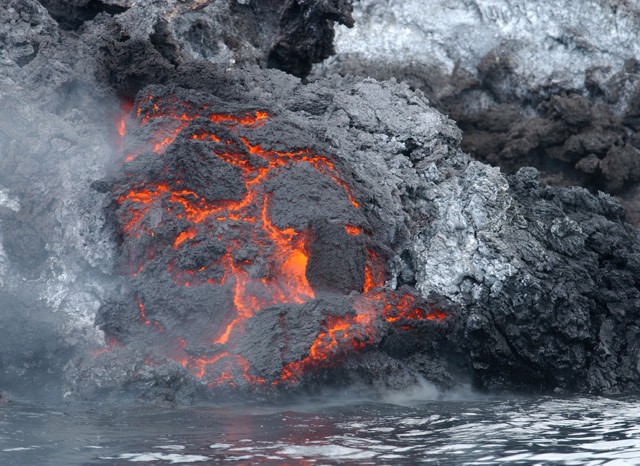 |
Figure 4. Lava entering the ocean at Jebel at Tair, 2 October 2007. U.S. Navy photo by Mass Communication Specialist 3rd Class Vincent J. Street. |
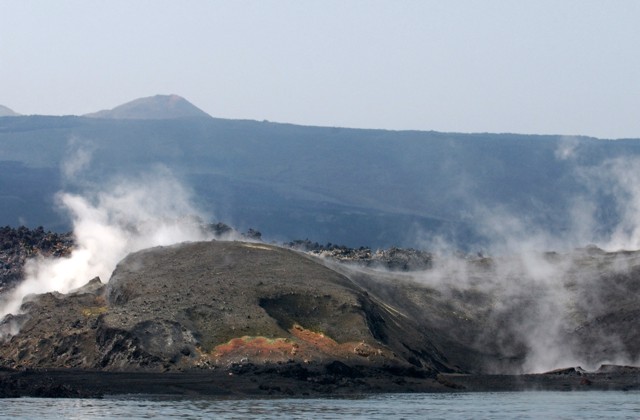 |
Figure 5. Steaming lava flows seen along the NW shoreline of Jebel at Tair, 2 October 2007. U.S. Navy photo by Mass Communication Specialist 3rd Class Vincent J. Street. |
Conflicting information reported by news media was attributed to the Yemen Earthquake Observation Centre regarding precursory seismicity. It appears that there was at least some level of increased seismicity in the Red Sea, perhaps as early as 7 September. Starting on 22 September earthquakes with magnitude 2.0-3.6 were allegedly recorded, with five of the larger ones occurring on 30 September. Some reports stated that there were three earthquakes up to M 4.3 on the afternoon of 30 September.
Evacuations and fatalities. Statements from Yemeni Coast Guard sources to news media soon after the onset of activity were that "around 50" soldiers had been evacuated from the island. Communications from the Yemeni Coast Guard to the NATO fleet, when assistance was requested on 30 September, indicated that 21 of the 29 soldiers on the island had been rescued with eight missing. Ships later rescued two soldiers and recovered the bodies of four soldiers from the Red Sea. Reports on 1 October by news media quoting evacuated soldiers and sources in the Yemeni Naval Forces indicated that 3-4 soldiers were killed at the onset of the eruption. One soldier stated that his comrades had been "burned by lava." No official statements were later made about fatalities among the soldiers, so it is unknown if these early reports were accurate.
Assistance from NATO. On the afternoon of 30 September 2007, Standing NATO Maritime Group 1 received a report of an explosion about 150 km N of the force. Two ships scouting ahead were on scene by late afternoon, confirming an eruption. The six NATO ships included Portuguese frigate NRP Alvares Cabral with her Lynx Mk95 helicopter, American destroyer USS Bainbridge, Dutch frigate HNLMS Evertsen, Danish frigate HDMS Olfert Fischer, German oiler FGS Spessart, and the previously mentioned Canadian frigate HMCS Toronto.
Working directly with the Yemen Coast Guard Operations Center, following an official request for assistance, NATO crews searched the volcanic debris-filled waters around the island throughout the night for survivors. After the Yemeni Coast Guard ended the search operation at daybreak and the NATO ships were departing the area, the USS Bainbridge sighted and recovered a survivor. He had drifted about 10 km N of the island, and was found at 0845 on 1 October. Shortly thereafter, HMCS Toronto recovered a second survivor. The only further discoveries were those of soldiers who perished at sea, two found by NATO and two by the Coast Guard.
Satellite imagery and data. Hot spots were detected in MODIS thermal infrared satellite imagery from Jebel at Tair beginning at 2220 (1920 UTC) on 30 September. Thermal anomalies detected by MODIS-MODVOLC continued on a daily basis through November 2007.
Aqua MODIS imagery taken at 1340 (1040 UTC) on 1 October showed a white plume covering the entire NE half of the island. A small white plume rising from the N end of the island was noticeable in visible MODIS imagery on 8 October. Also on 8 October, a Terra ASTER (Advanced Spaceborne Thermal Emission and Reflection Radiometer) image clearly showed recent lava flows emanating from the summit crater along with a thermal anomaly both in the crater and a small elongate anomaly, probably a lava flow or eruptive fissure, immediately to the NNE. Gas plumes were also rising from the summit crater and near-summit lava flows. Lava flows seen in the 8 October image had moved NE from the source before branching out and entering the sea across most of the NE coast at a distance of 2 km from the summit.
Another ASTER image acquired on 15 October (figure 7) provided evidence that the eruption was continuing, with a strong thermal anomaly from the summit crater and from summit-area lava flows. Two new areas of lava flows could be seen compared to the 8 October image, to the NNW and SE, each extending more than 400 m from the crater.
Sulfur dioxide emissions. The Ozone Monitoring Instrument (OMI) aboard NASA's Aura satellite detected significant SO2 emissions associated with the 30 September eruption. No SO2 emissions were apparent in OMI data collected at 1315 (1015 UTC) on 30 September. On 1 October at 1400 (1100 UTC) a large SO2 cloud was observed NW of the volcano over NE Sudan and the Red Sea (figure 8), and a less concentrated plume was emanating from the island. The total SO2 burden measured by OMI at this time was ~ 70 kilotons.
Subsequently, through 5 October, only very weak SO2 emissions were detected near the volcano. The SO2 cloud observed on 1 October continued to drift across the Arabian Peninsula and central Asia, and on 5 October the leading edge of the cloud reached Japan. The precise altitude of the SO2 cloud is currently unknown, but the speed and pattern of its dispersion, coupled with a relatively slow decrease in SO2 burden, imply that it was transported by the subtropical jet stream at an altitude of at least 10 km. This high altitude suggests an energetic eruption with high lava effusion rates in the early stages of the event.
Observations during November 2007. On 3 November at 0500 Captain Lars Melin and crew aboard the MV Falstaff observed the continuing activity. Incandescence and lava fountains (figure 9) were seen on the NW side of the island near the summit from 6-7 km offshore as the ship passed along the W side. Lava fountains were an estimated 20-50 m high.
Reference. Gass, I.G., Mallick, D.I.J., and Cox, K.G., 1973, Volcanic islands of the Red Sea: J Geol Soc London, v. 129, p. 275-310.
Geological Summary. The basaltic Jebel at Tair volcano rises from 1,200 m depth in the south-central Red Sea, forming an oval-shaped island about 3 km long. It is the northernmost known Holocene volcano in the Red Sea and lies SW of the Farisan Islands. Youthful basaltic pahoehoe lava flows from the steep-sided central vent, Jebel Duchan, cover most of the island, draping a circular cliff cut by wave erosion of an older edifice and extending beyond it to form a flat coastal plain. Pyroclastic cones are located along the NW and S coasts, and fumarolic activity occurs from two uneroded scoria cones at the summit. Radial fissures extend from the summit, some of which were the sources of lava flows. Explosive eruptions were reported in the 18th and 19th centuries, prior to an eruption in 2007-2008.
Information Contacts: Hawai'i Institute of Geophysics and Planetology (HIGP) Thermal Alerts System, School of Ocean and Earth Science and Technology (SOEST), Univ. of Hawai'i, 2525 Correa Road, Honolulu, HI 96822, USA (URL: http://modis.higp.hawaii.edu/); Simon Carn, Joint Center for Earth Systems Technology, University of Maryland Baltimore County (UMBC), 1000 Hilltop Circle, Baltimore, MD 21250 USA (URL: https://so2.gsfc.nasa.gov/); Lars Melin, M/V Falstaff, Sweden; NASA Earth Observatory (URL: http://earthobservatory.nasa.gov/); Ensign Matthew A. Goetz, US Navy, Staff Public Affairs Officer (SPAO); Yemen Observer (URL: http://www.yobserver.com/); Agence France Presse (URL: http://www.afp.com/); Yemen News Agency (SABA) (URL: http://www.sabanews.net/en/); Lookout Newspaper (URL: http://www.lookoutnewspaper.com/); Navy NewsStand, U.S. Navy; Deutsche Presse-Agentur (URL: http://www.dpa.de/); The Canadian Press (URL: http://www.thecanadianpress.com/); The Chronicle Herald (URL: http://thechronicleherald.ca/); Associated Press (URL: http://www.ap.org/).

